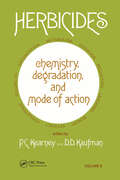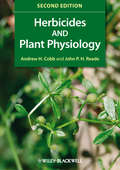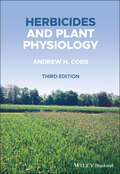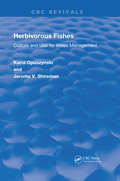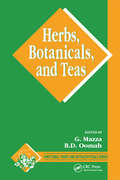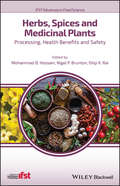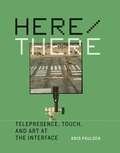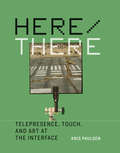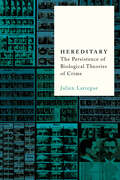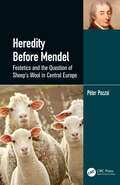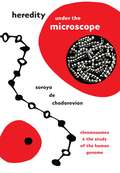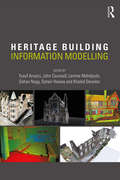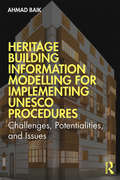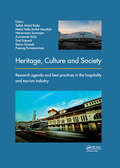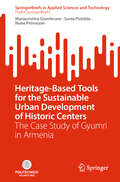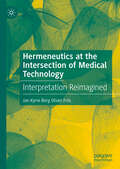- Table View
- List View
Herbicides Chemistry: Degradation and Mode of Action
by P.C. Kearney D.D KaufmanVolume 3: Conveniently gathering up-to-date information on herbicides' chemistry, degradation, and mode of action in one source, this reference discusses glyphosatc and the traits that have made it so successful ... investigates the adsorption of polycyclic alkanoic acids' ester into targeted plants ... documents sulfonylureas' selectivity, environmental compatibility, groundwater safety, and low use rate ... explains metribuzin's combination with other herbicides to increase weed control for soybeans, potatoes, and tomatoes ... and examines alachlor and metolachlor for controlling annual grasses, broadleaf weeds, yellow nutscdge in corn, soybeans, and many other crops. Extensively referenced and illustrated, Herbicides, Volume 3 is an outstanding reference for soil scientists, agronomists, microbiologists, biochemists, agricultural chemists, botanists, environmental scientists, and plant nutritionists and pathologists.
Herbicides and Plant Physiology
by Andrew H. Cobb John P. ReadeHerbicides make a spectacular contribution to modern crop production. Yet, for the development of more effective and safer agrochemicals, it is essential to understand how these compounds work in plants and their surroundings. This expanded and fully revised second edition of Herbicides and Plant Physiology provides a comprehensive and up-to-date account of how modern herbicides interact with target plants, and how they are used to manage crop production. In addition, the text: Provides a current account of the importance of weeds to crop yield and quality; Describes how new herbicides are discovered and developed; Examines precise sites of herbicide action and mechanisms of herbicide selectivity and resistance; Reviews commercial and biotechnological applications, including genetically engineered herbicide resistance in crops; Suggests new areas for future herbicide development; Includes many specially prepared illustrations. As a summary of diverse research information, this second edition of Herbicides and Plant Physiology is a valuable reference for students and researchers in plant physiology, crop production/protection, plant biochemistry, biotechnology and agriculture. All libraries in universities, agricultural colleges and research establishments where these subjects are studied and taught will need copies of this excellent book on their shelves.
Herbicides and Plant Physiology
by Andrew H. CobbHERBICIDES AND PLANT PHYSIOLOGY Discover the latest developments in herbicide and weed biology In the newly revised Third Edition of Herbicides and Plant Physiology, distinguished researcher Professor Dr. Andrew H. Cobb delivers an insightful and comprehensive examination of the interaction between herbicides and plant physiology. The book discusses many of the advances in plant physiology, utilizing data from the Arabidopsis genome, and gene editing techniques that have occurred in the last dozen years. This latest edition includes a variety of new and recent references addressing the latest developments in plant research. In addition to a complete introduction to weed biology, the book discusses the modern plant protection industry and the processes by which herbicides are discovered and developed. Readers will find discussions of new targets for the future development of new herbicides, as well as the mechanisms by which modern herbicides interact with plants and achieve their weed control objectives. The book also offers: Thorough introductions to weed biology, the modern plant protection products industry, and how herbicides are discovered and developed Comprehensive explorations of how herbicides gain entry into the plant and move to their sites of action, as well as the basis of herbicide selectivity Practical discussions of how herbicides interact with the major physiological processes in plants and accomplish weed control, including the inhibition of photosynthesis, pigment biosynthesis, and more Reviews recent developments following the use of genetically modified-herbicide resistant crops Perfect for plant biologists and agricultural scientists, this latest edition of Herbicides and Plant Physiology is an indispensable resource for anyone seeking a comprehensive and robust treatment of the latest advances in plant physiology and herbicide action.
Herbivorous Fishes: Culture and Use for Weed Management (Routledge Revivals)
by Karol Opuszynski, D.Sc Jerome V. Shireman, PhDPublished in 1995: This book is not designed as a culture manual for herbivorous fishes, but the reader is directed to other sources. This book should meet the needs that exist for a comprehensive publication on herbivorous fishes.
Herbs, Botanicals and Teas
by G. Mazza B. D. OomahHerbs, Botanicals and Teas presents the latest scientific and technical information on the chemical, pharmacological, epidemiological and clinical aspects of major herbal and tea products. Written by leading researchers contributing to the field, this is the first reference to provide in-depth coverage of garlic, ginseng, Echinacea, ginger, fenugre
Herbs, Spices and Medicinal Plants: Processing, Health Benefits and Safety (IFST Advances in Food Science)
by Mohammad B HossainThe latest research on the health benefits and optimal processing technologies of herbs and spices This book provides a comprehensive overview of the health benefits, analytical techniques used, and effects of processing upon the physicochemical properties of herbs and spices. Presented in three parts, it opens with a section on the technological and health benefits of herbs and spices. The second part reviews the effect of classical and novel processing techniques on the properties of herbs/spices. The third section examines extraction techniques and analytical methodologies used for herbs and spices. Filled with contributions from experts in academia and industry, Herbs, Spices and Medicinal Plants: Processing, Health Benefits and Safety offers chapters covering thermal and non-thermal processing of herbs and spices, recent developments in high-quality drying of herbs and spices, conventional and novel techniques for extracting bioactive compounds from herbs and spices, and approaches to analytical techniques. It also examines purification and isolation techniques for enriching bioactive phytochemicals, medicinal properties of herbs and spices, synergy in whole-plant medicine, potential applications of polyphenols from herbs and spices in dairy products, biotic and abiotic safety concerns, and adverse human health effects and regulation of metal contaminants in terrestrial plant-derived food and phytopharmaceuticals. Covers the emerging health benefits of herbs and spices, including their use as anti-diabetics, anti-inflammatories, and anti-oxidants Reviews the effect of classical and novel processing techniques on the properties of herbs and spices Features informed perspectives from noted academics and professionals in the industry Part of Wiley's new IFST Advances in Food Science series Herbs, Spices and Medicinal Plants is an important book for companies, research institutions, and universities active in the areas of food processing and the agri-food environment. It will appeal to food scientists and engineers, environmentalists, and food regulatory agencies.
Here Comes Everybody: The Power of Organizing Without Organizations
by Clay ShirkyClay Shirky's international bestseller Here Comes Everybody: How Change Happens When People Come Together explores how the unifying power of the internet is changing the character of human society. Welcome to the new future of involvement. Forming groups is easier than it's ever been: unpaid volunteers build Wikipedia together in their spare time, mistreated customers can join forces to get their revenge on airlines and high street banks, and one man with a laptop can raise an army to help recover a stolen phone. The results of this new world of easy collaboration can be both good (young people defying an oppressive government with a guerrilla ice-cream eating protest) and bad (girls sharing advice for staying dangerously skinny) but it's here and, as Clay Shirky shows, it's affecting. . . well, everybody. For the first time, we have the tools to make group action truly a reality. And they're going to change our whole world. 'As crisply argued and as enlightening a book about the internet as has been written' Daily Telegraph 'As usable as the technology he writes about' Independent 'Clay Shirky's masterpiece . . . glittering, brilliant insights that make me think, yes, of course, that's how it all works' Cory Doctorow, co-editor of Boing Boing 'Anyone interested in the vitality and influence of groups of human beings - from knitting circles, to political movements, to multinational corporations - needs to read this book' Steven Johnson, author of Everything Bad is Good for You and Emergence Clay Shirky writes, teaches, and consults on the social and economic effects of the internet. A professor at NYU's Interactive Telecommunications Program, he has consulted for Nokia, Procter and Gamble, News Corp. , the BBC, the US Navy, and Lego. Over the years, his writings have appeared in The New York Times, the Wall Street Journal, the Harvard Business Review, Wired, and IEEE Computer.
Here Comes the Sun
by Steve JonesOur sun drives the weather, forms the landscape, feeds and fuels - but sometimes destroys - the creatures that live upon it, controls their patterns of activity, makes chemicals in the skin that cheer up those who bask in its rays, and for the ancients was the seat of divine authority.In Here Comes the Sun, Steve Jones shows how life on Earth is ruled by our nearest star. It is filled with unexpected connections; between the need to stay cool and man's ability to stand upright, between the power of memory and the onset of darkness, between the flow of solar energy through the plants and animals and of wealth through society, and between Joseph Goebbel's 1938 scheme to make Edinburgh the summer capital of a defeated Britain and the widening gap in the life expectancy of Scottish men compared to that of other European men brought on by thnat nation's cloudy climate. Its author charts some of his own research in places hot and cold across the globe on the genetic and evolutionary effects of sunlight on snails, fruit-flies and people and shows how what was once no more an eccentric specialism has grown to become a subject of wide scientific, social and political significance. Stunningly evocative, beautifully written and packed full of insight, Here Comes the Sun is Steve Jones's most personal book to date.
Here Comes the Sun: How it feeds us, kills us, heals us and makes us what we are
by Professor Steve Jones'Illuminating!' Professor Brian Cox'Every Steve Jones book is a masterclass in clear and captivating writing with tantalising detours into beguiling anecdotes. Here Comes the Sun is dense with ideas and stories and, like all his books, it will change the way you see the world around you' Robin Ince Our sun drives the weather, forms the landscape, feeds and fuels - but sometimes destroys - the creatures that live upon it, controls their patterns of activity, makes chemicals in the skin that cheer up those who bask in its rays, and for the ancients was the seat of divine authority.In Here Comes the Sun, Steve Jones shows how life on Earth is ruled by our nearest star. It is filled with unexpected connections; between the need to stay cool and man's ability to stand upright, between the power of memory and the onset of darkness, between the flow of solar energy through the plants and animals and of wealth through society, and between Joseph Goebbel's 1938 scheme to make Edinburgh the summer capital of a defeated Britain and the widening gap in the life expectancy of Scottish men compared to that of other European men brought on by thnat nation's cloudy climate. Its author charts some of his own research in places hot and cold across the globe on the genetic and evolutionary effects of sunlight on snails, fruit-flies and people and shows how what was once no more an eccentric specialism has grown to become a subject of wide scientific, social and political significance. Stunningly evocative, beautifully written and packed full of insight, Here Comes the Sun is Steve Jones's most personal book to date.
Here/There: Telepresence, Touch, and Art at the Interface
by Kris Paulsen"Telepresence" allows us to feel present -- through vision, hearing, and even touch -- at a remote location by means of real-time communication technology. Networked devices such as video cameras and telerobots extend our corporeal agency into distant spaces. In Here/There, Kris Paulsen examines telepresence technologies through the lens of contemporary artistic experiments, from early video art through current "drone vision" works. Paulsen traces an arc of increasing interactivity, as video screens became spaces for communication and physical, tactile intervention. She explores the work of artists who took up these technological tools and questioned the aesthetic, social, and ethical stakes of media that allow us to manipulate and affect far-off environments and other people -- to touch, metaphorically and literally, those who cannot touch us back.Paulsen examines 1970s video artworks by Vito Acconci and Joan Jonas, live satellite performance projects by Kit Galloway and Sherrie Rabinowitz, and CCTV installations by Chris Burden. These early works, she argues, can help us make sense of the expansion of our senses by technologies that privilege real time over real space and model strategies for engagement and interaction with mediated others. They establish a political, aesthetic, and technological history for later works using cable TV infrastructures and the World Wide Web, including telerobotic works by Ken Goldberg and Wafaa Bilal and artworks about military drones by Trevor Paglen, Omar Fast, Hito Steyerl, and others. These works become a meeting place for here and there.
Here/There: Telepresence, Touch, and Art at the Interface (Leonardo)
by Kris PaulsenAn examination of telepresence technologies through the lens of contemporary artistic experiments, from early video art through current “drone vision” works."Telepresence” allows us to feel present—through vision, hearing, and even touch—at a remote location by means of real-time communication technology. Networked devices such as video cameras and telerobots extend our corporeal agency into distant spaces. In Here/There, Kris Paulsen examines telepresence technologies through the lens of contemporary artistic experiments, from early video art through current “drone vision” works. Paulsen traces an arc of increasing interactivity, as video screens became spaces for communication and physical, tactile intervention. She explores the work of artists who took up these technological tools and questioned the aesthetic, social, and ethical stakes of media that allow us to manipulate and affect far-off environments and other people—to touch, metaphorically and literally, those who cannot touch us back.Paulsen examines 1970s video artworks by Vito Acconci and Joan Jonas, live satellite performance projects by Kit Galloway and Sherrie Rabinowitz, and CCTV installations by Chris Burden. These early works, she argues, can help us make sense of the expansion of our senses by technologies that privilege real time over real space and model strategies for engagement and interaction with mediated others. They establish a political, aesthetic, and technological history for later works using cable TV infrastructures and the World Wide Web, including telerobotic works by Ken Goldberg and Wafaa Bilal and artworks about military drones by Trevor Paglen, Omar Fast, Hito Steyerl, and others. These works become a meeting place for here and there.
Hereditary: The Persistence of Biological Theories of Crime
by Julien LarregueSince the 1990s, a growing number of criminal courts around the world have been using expert assessments based on behavioral genetics and neuroscience to evaluate the responsibility and dangerousness of offenders. Despite this rapid circulation, however, we still know very little about the scientific knowledge underlying these expert evaluations. Hereditary traces the historical development of biosocial criminology in the United States from the 1960s to the present, showing how the fate of this movement is intimately linked to that of the field of criminology as a whole. In claiming to identify the biological and environmental causes of so-called "antisocial" behaviors, biosocial criminologists are redefining the boundary between the normal and the pathological. Julien Larregue examines what is at stake in the development of biosocial criminology. Beyond the origins of delinquency, Larregue addresses the reconfiguration of expertise in contemporary societies, and in particular the territorial struggles between the medical and legal professions. For if the causes of crime are both biological and social, its treatment may call for medical as well as legal solutions.
Heredity Before Mendel: Festetics and the Question of Sheep's Wool in Central Europe
by Péter PoczaiThe history of Science is replete with untold stories and this book is one of these accounts. The author shares a narrative of heredity, an active topic of inquiry long before Gregor Mendel – the father of genetics – planted his peas. One such interlude unfolded in Mendel’s home city and involved the sheep breeder, Imre Festetics. He sought to improve wool and proposed important rules of heredity. Unfortunately, aspects of wool quality, now known to be polygenic, complicate interpretations of the work of Festetics and explain why it is neglected. The forebearers of Mendel never get the credit they deserve. Heredity Before Mendel resurrects Festetics, the grandfather of heredity. Key Features 1) Documents a vibrant community of scholars interested in heredity before Mendel 2) Highlights the work of Imre Festetics, the forgotten grandfather of genetics 3) Desribes political repression which stifled the nascent foundation of heredity research 4) Emphasizes the role sheep and wool played as the first model system of genetics 5) Challenges19th century taboos in Moravia leading to malicious rumors about the inbred royal House of Austria (Habsburgs).
Heredity under the Microscope: Chromosomes and the Study of the Human Genome
by Soraya de ChadarevianBy focusing on chromosomes, Heredity under the Microscope offers a new history of postwar human genetics. Today chromosomes are understood as macromolecular assemblies and are analyzed with a variety of molecular techniques. Yet for much of the twentieth century, researchers studied chromosomes by looking through a microscope. Unlike any other technique, chromosome analysis offered a direct glimpse of the complete human genome, opening up seemingly endless possibilities for observation and intervention. Critics, however, countered that visual evidence was not enough and pointed to the need to understand the molecular mechanisms. Telling this history in full for the first time, Soraya de Chadarevian argues that the often bewildering variety of observations made under the microscope were central to the study of human genetics. Making space for microscope-based practices alongside molecular approaches, de Chadarevian analyzes the close connections between genetics and an array of scientific, medical, ethical, legal, and policy concerns in the atomic age. By exploring the visual evidence provided by chromosome research in the context of postwar biology and medicine, Heredity under the Microscope sheds new light on the cultural history of the human genome.
Heritage
by Sean Brock Peter Frank EdwardsNew York Times best sellerWinner, James Beard Foundation Award, Best Book of the Year in American CookingWinner, IACP Julia Child First Book Award Sean Brock is the chef behind the game-changing restaurants Husk and McCrady’s, and his first book offers all of his inspired recipes. With a drive to preserve the heritage foods of the South, Brock cooks dishes that are ingredient-driven and reinterpret the flavors of his youth in Appalachia and his adopted hometown of Charleston. The recipes include all the comfort food (think food to eat at home) and high-end restaurant food (fancier dishes when there’s more time to cook) for which he has become so well-known. Brock’s interpretation of Southern favorites like Pickled Shrimp, Hoppin’ John, and Chocolate Alabama Stack Cake sit alongside recipes for Crispy Pig Ear Lettuce Wraps, Slow-Cooked Pork Shoulder with Tomato Gravy, and Baked Sea Island Red Peas. This is a very personal book, with headnotes that explain Brock’s background and give context to his food and essays in which he shares his admiration for the purveyors and ingredients he cherishes.
Heritage Building Conservation: Sustainable and Digital Modelling
by Mohamed MarzoukThis book provides a holistic perspective on the sustainable conservation of heritage buildings through outlining the factors that influence the preservation, operational performance and maintainability of heritage buildings and the application of new methodologies and technologies. Using real cases from Egypt, a country which comprises a vast number of unique heritage structures, each of which is deteriorating at its own pace, this book presents a systematic, data-based approach to manage aging and deteriorating heritage assets in a cost-effective way. The authors initially provide an overview and history of conservation and maintenance work as well as the current codes and standards that regulate the preservation of these buildings. Further chapters then cover: The technology used to digitally document heritage buildings, including LIDAR, photogrammetry, Heritage Building Information Modelling (HBIM), and Virtual Reality (VR) technologies Introducing a Maintainability Index of Heritage Buildings (MIHB) to support the decision-making and prioritization process for the maintenance of heritage buildings The adaptive reuse of heritage buildings Modelling embodied and operational energy performance Using Chatbot and Blockchain technology to support the management and preservation of heritage buildings Ultimately, this book presents a useful tool for use in heritage management and highlights how the reusability of heritage buildings is critical to the creation and survival of sustainable communities. It will be useful reading for researchers, architects, engineers and especially those involved in the management of heritage buildings.
Heritage Building Information Modelling
by Yusuf Arayici John Counsell Lamine Mahdjoubi Gehan Ahmed Nagy Soheir Hawas Khaled DweidarBuilding Information Modelling (BIM) is being debated, tested and implemented wherever you look across the built environment sector. This book is about Heritage Building Information Modelling (HBIM), which necessarily differs from the commonplace applications of BIM to new construction. Where BIM is being used, the focus is still very much on design and construction. However, its use as an operational and management tool for existing buildings, particularly heritage buildings, is lagging behind. The first of its kind, this book aims to clearly define the scope for HBIM and present cutting-edge research findings alongside international case studies, before outlining challenges for the future of HBIM research and practice. After an extensive introduction to HBIM, the core themes of the book are arranged into four parts: Restoration philosophies in practice Data capture and visualisation for maintenance and repair Building performance Stakeholder engagement This book will be a key reference for built environment practitioners, researchers, academics and students engaged in BIM, HBIM, building energy modelling, building surveying, facilities management and heritage conservation more widely.
Heritage Building Information Modelling for Implementing UNESCO Procedures: Challenges, Potentialities, and Issues
by Ahmad Hamed BaikThe main aim of this book is to develop and explore the value of new innovative digital content to help satisfy UNESCO’s World Heritage nomination file requirements. Through a detailed exploration of two BIM case studies from Jeddah, Saudi Arabia, the book uniquely connects the use of Heritage BIM to the documentation methods used by UNESCO and demonstrates how this provides a contribution to both countries with heritage sites and UNESCO as an organisation. The research and practical examples in the book seek to address both the lack of a comprehensive method of submitting a nomination file to UNESCO and the lack of authentic engineering information in countries where extensive heritage sites exist. It looks at answering the following questions: How can Heritage Building Information Modelling (HBIM) be used to better maintain, protect, and record the updated information of historical buildings? How can HBIM provide innovation in creating the missing information for the assignment of UNESCO's World Heritage status? What additional value can a sustainable update of HBIM data provide for such sites? How can HBIM improve the cultural value of heritage buildings in the short, medium, and long term, as well as provide a better future for historical buildings? This book will be useful reading for researchers and practitioners in the areas of heritage conservation, archaeology, World Heritage nomination, HBIM, digital technology and engineering, remote sensing, laser scanning, and architectural technology.
Heritage Education for Climate Action
by Irene G. Curulli Deniz Ikiz Kaya Arghavan KhaefiCultural heritage is increasingly recognized for its contributions to the transition to climate action, and heritage education can play an important role in developing climate adaptation competencies. These can foster positive dialogs surrounding climate change, shift attitudes and inspire actions. However, achieving these goals requires bridging the gap between policy, practice and local capacity building, as well as integrating a multi- and transdisciplinary approach into traditional higher education curricula and models. Bringing together knowledge, practice and experiences from different disciplinary silos, this book provides a wide set of innovative teaching and learning methods, tools and pedagogical models that can be adapted to heritage education in order to address climate issues. Organized into four parts, Heritage Education for Climate Action covers a wide array of international experiences, real-life cases and practices, focusing on heritage and resilience building, vulnerability and risk assessment, climate change adaptation, mitigation and policymaking. This book is therefore a source of suggestions and ideas for scholars, educators and professionals who want to develop future climate leadership and contribute to the transition of heritage education toward sustainable development and climate action.
Heritage Wood: Investigation and Conservation of Art on Wood (Cultural Heritage Science)
by Austin Nevin Malgorzata SawickiThis volume highlights recent research efforts in the conservation and investigation of works of art on wood. Through eleven case studies it showcases different experimental methods ranging from X-ray analysis of objects to the study of cross-sections made from micro-samples. New research focusing on the technical study, treatment and assessment of works of art on wood in its many forms is featured in this edited volume. Technical studies include the attribution and investigations of a triptych by Hans Memling and a sculpture from workshop of Michel and Gregor Erhart, decorated Syrian rooms, and investigations of finely carved Gothic wooden objects. Synchrotron-based methods are presented for studying the alteration of 19th c. verdigris in Norway, and multi-analytical methods are employed for the investigations of 16th to 19th c. East Asian lacquer from the Kunsthistorisches Museum in Vienna. Novel methods for the cleaning of gilded surfaces using gels and emulsions are shown, as are innovative strategies for the consolidation for waterlogged wood, providing key data for the assessment of risks and benefits of new methods, and the short and long-term effects on gilding layers and archaeological wood. The book clearly shows how collaboration between engineers, physicists, biologists and chemists and conservators of different types of materials can lead to new research in conservation science. This book is crucial reading for conservators and conservation scientists, as well as for technical art historians, providing key methodological case studies of polychromy from different temporal and geographical contexts.
Heritage for a Sustainable Development: Case Studies from Armenia (SpringerBriefs in Applied Sciences and Technology)
by Mariacristina Giambruno Sonia PistiddaThis book explores the potential contribution of cultural heritage in the enhancement of the territories, investigating the possibilities but also the criticalities involved in the process. Based on the knowledge process built on the Monasteries of Haghpat, Sanahin, Geghard and moreover, in the Upper Azat Valley in Armenia, the work suggests the development of an integrated design approach with interdisciplinary focus. The conservation of the Architectural Heritage of these sites is a priority for the identity safeguard but also to start virtuous processes able to ensure a sustainable development for places and communities. The objective of this work is the setting of pilot strategies and guidelines for the preservation and promotion of cultural heritage as an engine for a compatible and sustainable tourism development of the area, with tangible impact on social and economic development of the country. The work would benefit local authorities and communities, as well as researchers involved in these topics.
Heritage, Culture and Society: Research agenda and best practices in the hospitality and tourism industry
by Salleh Mohd Radzi, Mohd Hafiz Mohd Hanafiah, Norzuwana Sumarjan, Zurinawati Mohi, Didi Sukyadi, Karim Suryadi & Pupung PurnawarmanHeritage, Culture and Society contains the papers presented at the 3rd International Hospitality and Tourism Conference (IHTC2016) & 2nd International Seminar on Tourism (ISOT 2016), Bandung, Indonesia, 10—12 October 2016). The book covers 7 themes: i) Hospitality and tourism managementii) Hospitality and tourism marketingiii) Current trends in hospitality and tourism managementiv) Technology and innovation in hospitality and tourismv) Sustainable tourismvi) Gastronomy, foodservice and food safety, and vii) Relevant areas in hospitality and tourism Heritage, Culture and Society is a significant contribution to the literature on Hospitality and Tourism, and will be of interest to professionals and academia in both areas.
Heritage-Based Tools for the Sustainable Urban Development of Historic Centers: The Case Study of Gyumri in Armenia (SpringerBriefs in Applied Sciences and Technology)
by Mariacristina Giambruno Sonia Pistidda Nune PetrosyanThis book proposes a heritage-based approach for the sustainable urban development of the historic cities. The rapid growth of the cities, under the pressure of globalization processes and climate changes, implies deep transformations in their cultural asset, neglecting the role of urban heritage. Often urban planning instruments are not properly equipped with tools capable of managing the complexity of historic cities. The book fills a gap in the implementation of urban transformation, taking into consideration the urgency to protect sensitive and fragile parts of the historic city. The heritage-based tools are experimented with by using a unique case study in the Armenian context: the city of Gyumri and its historic center that, after the 1988 earthquake, suffered from a progressive degradation of its historical heritage. The book serves as a support for the implementation of the planning and regulation for the specific case study and as a methodological approach for planning the historic centers, replicable in other Armenian old cities and similar cities outside Armenia. It provides a framework for protecting the historic environment and buildings, as well as a tool for urban identity protection and a driver for economic development. The practical guidance also offers suggestions to inhabitants and technicians who must deal with the preservation of buildings and open spaces.
Hermeneutics at the Intersection of Medical Technology: Interpretation Reimagined
by Jan Kyrre FriisThis book explores the crucial role of interpretation in medical radiology and beyond, emphasizing its pervasive influence on medical knowledge. Friis examines radiological analysis through hermeneutics, cognition, and visual perception studies. He argues that interpretation is inherently embodied and essential to human action, particularly in radiology, where technology extends vision beyond the human eye&’s limits. Yet, interpretation varies among radiologists. Can it be too relative, shaped by subjective factors irrelevant to the task? Attempts to eliminate cognitive bias through psychophysical and cognitivist approaches have failed. Interpretation is an active, context-dependent process, inseparable from human experience. Friis contends that the only solution is to expand cognitive reach through collaborative interpretative practices, integrating diverse perspectives. Radiology, like all medical fields, benefits from shared expertise, where multiple viewpoints refine diagnostic accuracy and mitigate individual bias. By fostering structured cooperation among radiologists, clinicians, interpretative reliability can be strengthened. The key is not to eliminate subjectivity but to harness it constructively through interdisciplinary dialogue, collective reasoning, and continuous knowledge exchange.
Hero For The Hungry: The Life And Work Of Norman Borlaug
by Peggy Thomas Sam KaldaA moving and informative biography of the 20th-century American agriculture scientist whose innovations in crop varieties founded the Green Revolution and fed hundreds of millions of people around the world - with full-color chapter illustrations and STEM - and history-themed text features throughout. Can a quiet Iowa farm boy grow up to change the world? Norman Ernest Borlaug did. Born in 1914, raised on a small farm, and educated in a one-room schoolhouse, Norman Borlaug learned to work hard and excelled in sports, and later studied forestry in college, eventually becoming a plant scientist. Readers will discover how even from a young age Norman Borlaug dedicated his life’s work to ending world hunger. Working in obscurity in the wheat fields of Mexico in the 50s and 60s, Norm and his team developed disease-resistant plants, and when widespread famine threatened India and Pakistan, Norm worked alongside poor farmers, battled bureaucracy, and fearlessly stood up to heads of state to save millions of lives from mass starvation. Often called the “Father of the Green Revolution,” Norm helped lay the groundwork for agricultural technological advances that alleviated world hunger, and he went on to win the Nobel Prize for Peace in 1970. He was a true hero for the hungry. Text features throughout the book include: Sidebars on the science of plant hybridization and pathology Norman was using to produce new and better wheat varieties Information on a range of agriculture and plant life concepts, including agronomy, wheat genes, photoperiodism, stem rust, nutrients and more Back matter including a timeline of events and discoveries, and a call to action for readers to think about how they can use science to solve problems and how they can do small things to help with hunger and food waste Hero for the Hungry is excellent for a science class learning about genetics, an agriculture class studying agronomy, or a history or English class looking for a well-written biography on a hero scientist.
